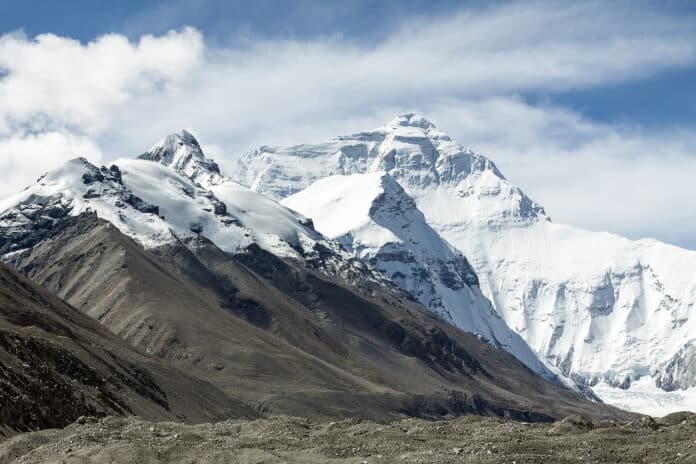Microbial communities in alpine environments have not been well studied using modern cultivation-independent sequencing approaches due to the challenges and danger associated with reaching such high elevations. For this reason, we know little about the microorganisms found in sediments on Earth’s tallest mountains, how they reach these surfaces, and how they survive and remain active at such extreme elevations.
A new CU Boulder-led study explored the microbial diversity recovered from three sediment samples collected from the South Col of Sagarmatha (Mount Everest). They found a very low diversity of bacteria, protists, and fungi that included a combination of cosmopolitan taxa and specialized microorganisms often found at high elevations, like those of the genera Modestobacter and Naganishia.
The study highlights an invisible impact of tourism on the world’s highest mountain. It could also lead to a better understanding of environmental limits to life on Earth and where life may exist on other planets or cold moons.
Steve Schmidt, senior author of the paper and professor of ecology and evolutionary biology, said, “There is a human signature frozen in the microbiome of Everest, even at that elevation.”
Previously, scientists were unable to identify human-associated microbes in samples collected above 26,000 feet. In this study, scientists used both culturing and next-generation sequencing approaches (16S rRNA gene, internal transcribed spacer [ITS] region, and 18S rRNA gene sequencing) for identification. This study marks the first time next-generation gene sequencing technology has been used to analyze soil from such a high elevation on Mount Everest.
The findings didn’t surprise scientists: they found microorganisms left by humans.
Schmidt said, “Microbes are everywhere, even in the air, and can easily blow around and land some distance from nearby camps or trails. If somebody even blew their nose or coughed, that’s the kind of thing that might show up.”
What they were impressed by, however, was that certain microbes which have evolved to thrive in warm and wet environments like our noses and mouths were resilient enough to survive in a dormant state in such harsh conditions.
Scientists identified the DNA of almost any living or dead microbes in the soil. They then conducted extensive bioinformatics analyses of the DNA sequences to determine the diversity of organisms rather than their abundances.
Most of the microbial DNA sequences they discovered matched those of hardy, or “extremophilic,” organisms that had already been documented in other high-elevation locations in the Andes and Antarctica. A fungus in the genus Naganishia that can tolerate extremely high levels of cold and UV radiation was the most prevalent organism they discovered using old and modern techniques.
But they also found microbial DNA for some organisms heavily associated with humans, including Staphylococcus, one of the most common skin and nose bacteria, and Streptococcus, a dominant genus in the human mouth.
Microbes are frequently killed by ultraviolet radiation, cold temperatures, and a lack of water at high elevations. Only the most resilient animals survive. But, some species, like Naganishia, may flourish quickly when water and the ideal ray of sunshine offer enough heat to aid it in temporarily prospering. Most organisms, like the microorganisms brought up tremendous heights by humans, fall dormant or perish.
The researchers don’t expect this microscopic impact on Everest to affect the broader environment significantly. But this work does carry implications for the potential for life far beyond Earth if, one day, humans step foot on Mars or beyond.
Journal Reference:
- Nicholas Dragone, L. Baker Perry, et al. Genetic analysis of the frozen microbiome at 7900 m a.s.l., on the South Col of Sagarmatha (Mount Everest). Arctic, Antarctic, and Alpine Research. DOI: 10.1080/15230430.2023.2164999
